air condition MAZDA MODEL 3 HATCHBACK 2012 Owners Manual (in English)
[x] Cancel search | Manufacturer: MAZDA, Model Year: 2012, Model line: MODEL 3 HATCHBACK, Model: MAZDA MODEL 3 HATCHBACK 2012Pages: 525, PDF Size: 5.95 MB
Page 4 of 525
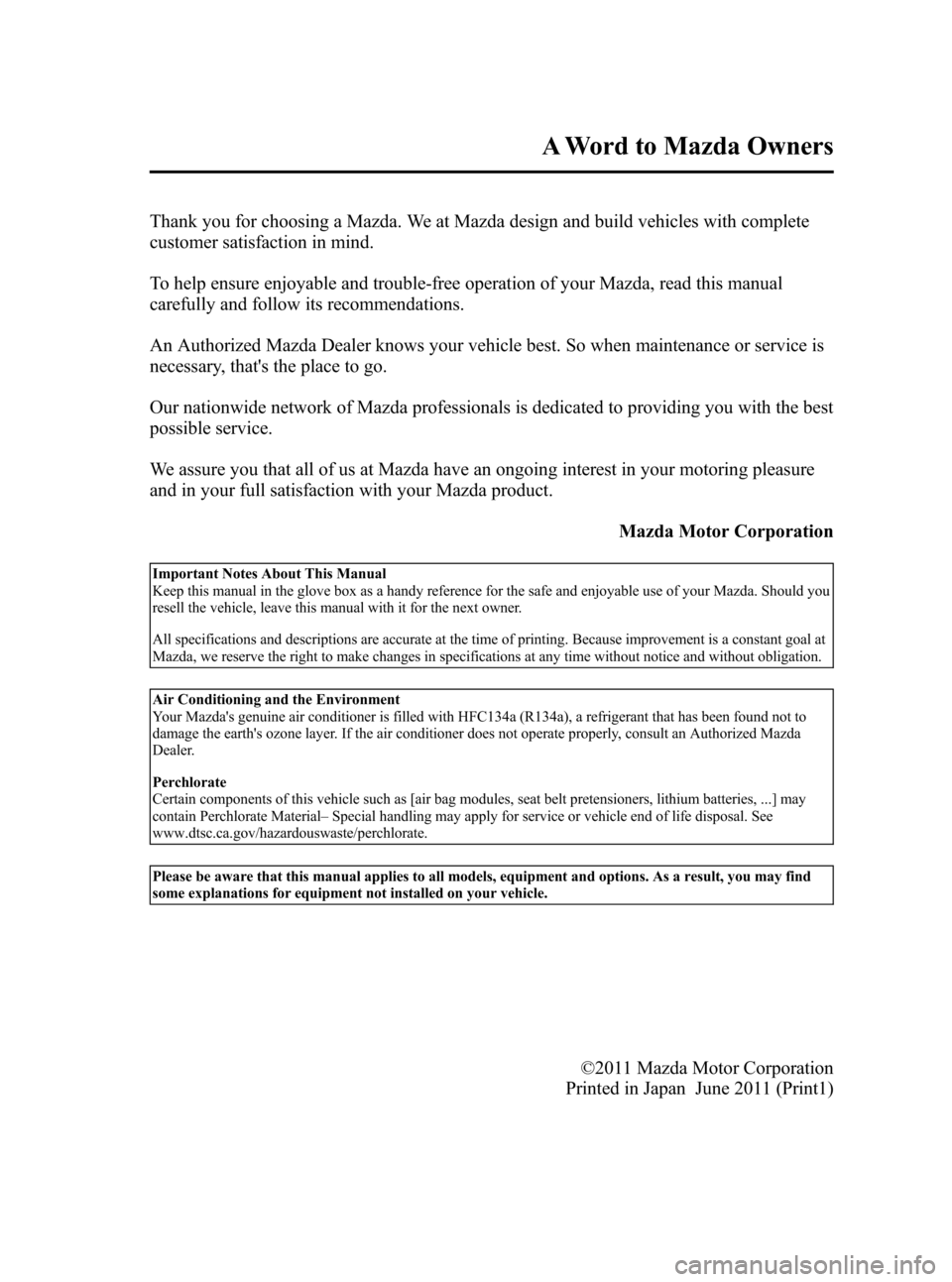
Black plate (3,1)
Thank you for choosing a Mazda. We at Mazda design and build vehicles with complete
customer satisfaction in mind.
To help ensure enjoyable and trouble-free operation of your Mazda, read this manual
carefully and follow its recommendations.
An Authorized Mazda Dealer knows your vehicle best. So when maintenance or service is
necessary, that's the place to go.
Our nationwide network of Mazda professionals is dedicated to providing you with the best
possible service.
We assure you that all of us at Mazda have an ongoing interest in your motoring pleasure
and in your full satisfaction with your Mazda product.Mazda Motor Corporation
Important Notes About This Manual
Keep this manual in the glove box as a handy reference for the safe and enjoyable use of your Mazda. Should you
resell the vehicle, leave this manual with it for the next owner.
All specifications and descriptions are accurate at the time of printing. Because improvement is a constant goal at
Mazda, we reserve the right to make changes in specifications at any time without notice and without obligation.
Air Conditioning and the Environment
Your Mazda's genuine air conditioner is filled with HFC134a (R134a), a refrigerant that has been found not to
damage the earth's ozone layer. If the air conditioner does not operate properly, consult an Authorized Mazda
Dealer.
Perchlorate
Certain components of this vehicle such as [air bag modules, seat belt pretensioners, lithium batteries, ...] may
contain Perchlorate Material–Special handling may apply for service or vehicle end of life disposal. See
www.dtsc.ca.gov/hazardouswaste/perchlorate.
Please be aware that this manual applies to all models, equipment and options. As a result, you may find
some explanations for equipment not installed on your vehicle.
©2011 Mazda Motor Corporation
Printed in Japan June 2011 (Print1)
A Word to Mazda Owners
Mazda3_8BY7-EC-11F_Edition1 Page3
Friday, June 17 2011 2:53 PM
Form No.8BY7-EC-11F
Page 6 of 525

Black plate (5,1)
Mazda3_8BY7-EC-11F_Edition1 Page5
Friday, June 17 2011 2:54 PM
Form No.8BY7-EC-11F
Table of Contents
Your Vehicle at a Glance
Interior, exterior views and part identification of your Mazda.1
Essential Safety Equipment
Use of safety equipment, including seats, seat belt system, child-restraint
systems and SRS air bags.2
Knowing Your Mazda
Explanation of basic operations and controls; opening/closing and adjustment
of various parts.3
Before Driving Your Mazda
Important information about driving your Mazda.4
Driving Your Mazda
Explanation of instruments and controls.5
Interior Comfort
Use of various features for drive comfort, including air-conditioning and audio
system.6
In Case of an Emergency
Helpful information on what to do in an emergency.7
Maintenance and Care
How to keep your Mazda in top condition.8
Customer Information
Important consumer information including warranties and add-on equipment.9
Specifications
Technical information about your Mazda.10
Index11
Page 39 of 525
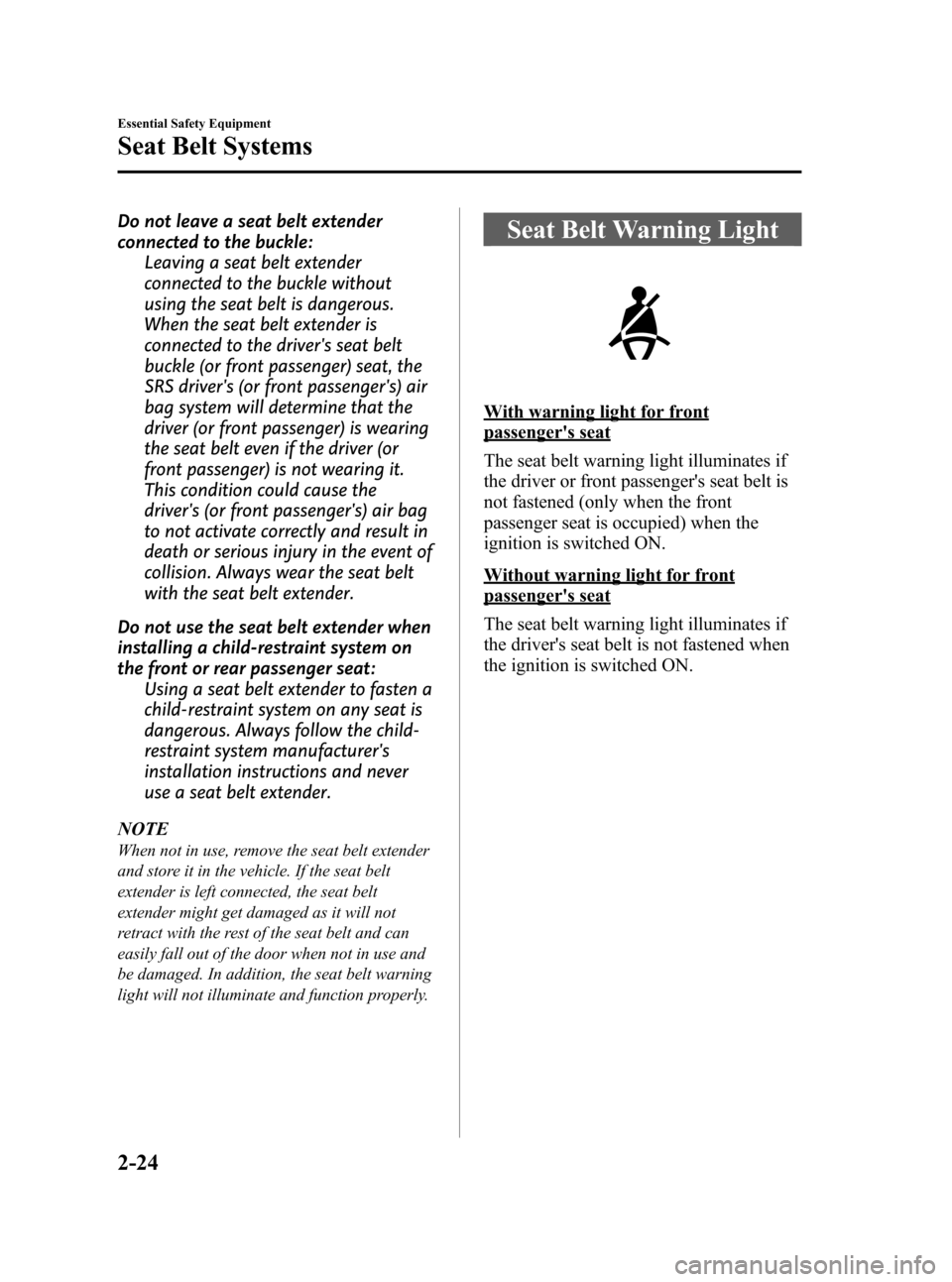
Black plate (38,1)
Do not leave a seat belt extender
connected to the buckle:Leaving a seat belt extender
connected to the buckle without
using the seat belt is dangerous.
When the seat belt extender is
connected to the driver's seat belt
buckle (or front passenger) seat, the
SRS driver's (or front passenger's) air
bag system will determine that the
driver (or front passenger) is wearing
the seat belt even if the driver (or
front passenger) is not wearing it.
This condition could cause the
driver's (or front passenger's) air bag
to not activate correctly and result in
death or serious injury in the event of
collision. Always wear the seat belt
with the seat belt extender.
Do not use the seat belt extender when
installing a child-restraint system on
the front or rear passenger seat: Using a seat belt extender to fasten a
child-restraint system on any seat is
dangerous. Always follow the child-
restraint system manufacturer's
installation instructions and never
use a seat belt extender.
NOTE
When not in use, remove the seat belt extender
and store it in the vehicle. If the seat belt
extender is left connected, the seat belt
extender might get damaged as it will not
retract with the rest of the seat belt and can
easily fall out of the door when not in use and
be damaged. In addition, the seat belt warning
light will not illuminate and function properly.
Seat Belt Warning Light
With warning light for front
passenger's seat
The seat belt warning light illuminates if
the driver or front passenger's seat belt is
not fastened (only when the front
passenger seat is occupied) when the
ignition is switched ON.
Without warning light for front
passenger's seat
The seat belt warning light illuminates if
the driver's seat belt is not fastened when
the ignition is switched ON.
2-24
Essential Safety Equipment
Seat Belt Systems
Mazda3_8BY7-EC-11F_Edition1 Page38
Friday, June 17 2011 2:54 PM
Form No.8BY7-EC-11F
Page 44 of 525
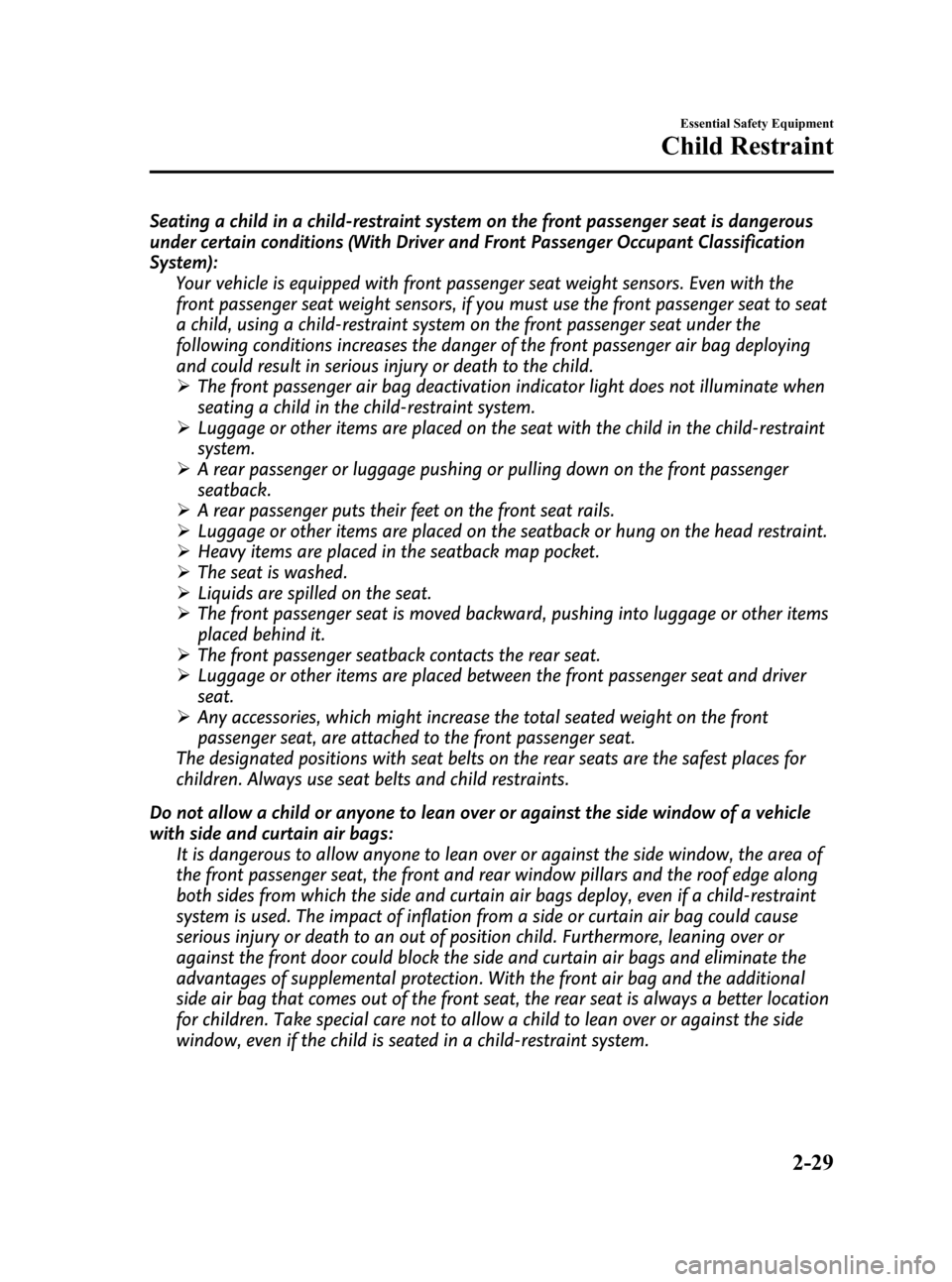
Black plate (43,1)
Seating a child in a child-restraint system on the front passenger seat is dangerous
under certain conditions (With Driver and Front Passenger Occupant Classification
System):Your vehicle is equipped with front passenger seat weight sensors. Even with the
front passenger seat weight sensors, if you must use the front passenger seat to seat
a child, using a child-restraint system on the front passenger seat under the
following conditions increases the danger of the front passenger air bag deploying
and could result in serious injury or death to the child.
ØThe front passenger air bag deactivation indicator light does not illuminate when
seating a child in the child-restraint system.
Ø Luggage or other items are placed on the seat with the child in the child-restraint
system.
Ø A rear passenger or luggage pushing or pulling down on the front passenger
seatback.
Ø A rear passenger puts their feet on the front seat rails.
Ø Luggage or other items are placed on the seatback or hung on the head restraint.
Ø Heavy items are placed in the seatback map pocket.
Ø The seat is washed.
Ø Liquids are spilled on the seat.
Ø The front passenger seat is moved backward, pushing into luggage or other items
placed behind it.
Ø The front passenger seatback contacts the rear seat.
Ø Luggage or other items are placed between the front passenger seat and driver
seat.
Ø Any accessories, which might increase the total seated weight on the front
passenger seat, are attached to the front passenger seat.
The designated positions with seat belts on the rear seats are the safest places for
children. Always use seat belts and child restraints.
Do not allow a child or anyone to lean over or against the side window of a vehicle
with side and curtain air bags: It is dangerous to allow anyone to lean over or against the side window, the area of
the front passenger seat, the front and rear window pillars and the roof edge along
both sides from which the side and curtain air bags deploy, even if a child-restraint
system is used. The impact of inflation from a side or curtain air bag could cause
serious injury or death to an out of position child. Furthermore, leaning over or
against the front door could block the side and curtain air bags and eliminate the
advantages of supplemental protection. With the front air bag and the additional
side air bag that comes out of the front seat, the rear seat is always a better location
for children. Take special care not to allow a child to lean over or against the side
window, even if the child is seated in a child-restraint system.
Essential Safety Equipment
Child Restraint
2-29
Mazda3_8BY7-EC-11F_Edition1 Page43
Friday, June 17 2011 2:54 PM
Form No.8BY7-EC-11F
Page 69 of 525

Black plate (68,1)
SRS Air Bag Deployment Criteria
This chart indicates the applicable SRS equipment that will deploy depending on the type
of collision.
(The illustrations are the representative cases of collisions.)
SRS
equipment Types of collision
A severe frontal/near frontal collision A severe side collision A rear collision
Front seat belt
pretensioner X*1(both sides)
X*1(impact side only)
No air bag and front seat
belt pretensioner will be
activated in a rear collision.
Driver air
bag X
Front
passenger air bag X
*1
Side air
bagíX*1(impact side only)
Curtain air bag
íX (impact side only)
X: The SRS air bag equipment is designed to deploy in a collision.
*1: (With Driver and Front Passenger Occupant Classification System)
The front passenger front and side air bags and the seat belt pretensioner are designed
to deploy depending on the condition of the total seated weight on the front passenger
seat.
2-54
Essential Safety Equipment
íSome models.
SRS Air Bags
Mazda3_8BY7-EC-11F_Edition1 Page68
Friday, June 17 2011 2:54 PM
Form No.8BY7-EC-11F
Page 72 of 525
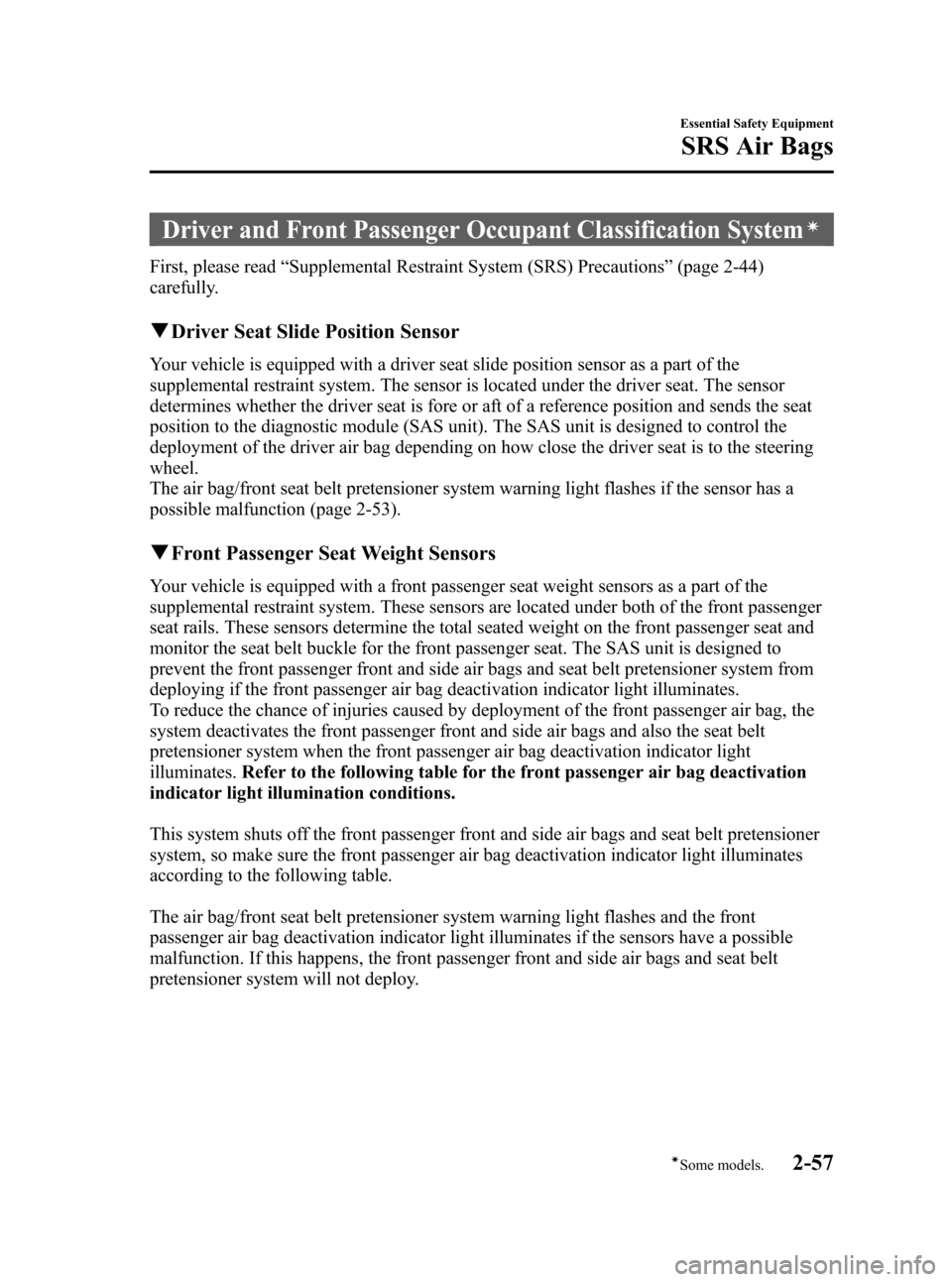
Black plate (71,1)
Driver and Front Passenger Occupant Classification Systemí
First, please read“Supplemental Restraint System (SRS) Precautions” (page 2-44)
carefully.
q Driver Seat Slide Position Sensor
Your vehicle is equipped with a driver seat slide position sensor as a part of the
supplemental restraint system. The sensor is located under the driver seat. The sensor
determines whether the driver seat is fore or aft of a reference position and sends the seat
position to the diagnostic module (SAS unit). The SAS unit is designed to control the
deployment of the driver air bag depending on how close the driver seat is to the steering
wheel.
The air bag/front seat belt pretensioner system warning light flashes if the sensor has a
possible malfunction (page 2-53).
qFront Passenger Seat Weight Sensors
Your vehicle is equipped with a front passenger seat weight sensors as a part of the
supplemental restraint system. These sensors are located under both of the front passenger
seat rails. These sensors determine the total seated weight on the front passenger seat and
monitor the seat belt buckle for the front passenger seat. The SAS unit is designed to
prevent the front passenger front and side air bags and seat belt pretensioner system from
deploying if the front passenger air bag deactivation indicator light illuminates.
To reduce the chance of injuries caused by deployment of the front passenger air bag, the
system deactivates the front passenger front and side air bags and also the seat belt
pretensioner system when the front passenger air bag deactivation indicator light
illuminates. Refer to the following table for the front passenger air bag deactivation
indicator light illumination conditions.
This system shuts off the front passenger front and side air bags and seat belt pretensioner
system, so make sure the front passenger air bag deactivation indicator light illuminates
according to the following table.
The air bag/front seat belt pretensioner system warning light flashes and the front
passenger air bag deactivation indicator light illuminates if the sensors have a possible
malfunction. If this happens, the front passenger front and side air bags and seat belt
pretensioner system will not deploy.
Essential Safety Equipment
SRS Air Bags
2-57íSome models.
Mazda3_8BY7-EC-11F_Edition1 Page71
Friday, June 17 2011 2:54 PM
Form No.8BY7-EC-11F
Page 73 of 525

Black plate (72,1)
Front passenger air bag deactivation indicator light
This indicator light illuminates to remind you that the front passenger front and side air
bags and seat belt pretensioner will not deploy during a collision.
If the front passenger weight sensors are normal, the indicator light illuminates when the
ignition is switched ON. The light turns off after a few seconds.
The front passenger air bag deactivation indicator light illuminates or is off under the following conditions:Condition detected by the
front passenger occupant
classification system Front passenger air bag
deactivation indicator light Front passenger front and
side air bags Front passenger seat
belt pretensioner
system
Empty (Not occupied)
*1Off Deactivated Deactivated
Child or child-restraint
system
*2On Deactivated Deactivated
Adult
*3Off ReadyReady
*1 : If the front passenger seat belt is buckled, the front passenger air bag deactivation indicator light illuminates, however this does not indicate a malfunction.
*2 : If a larger child sits on the front passenger seat, the sensors might detect the child as being an adult depending on the child's physique.
*3 : If a smaller adult sits on the front passenger seat, the sensors might detect the person as being a child
depending on the person's physique.
The curtain air bag is ready for inflating despite the chart above.
If the front passenger air bag deactivation indicator light does not illuminate when the
ignition is switched ON and does not illuminate as indicated in the above chart, do not
allow a child to sit in the front passenger seat and consult an Authorized Mazda Dealer as
soon as possible. The system may not work properly in an accident.
2-58
Essential Safety Equipment
SRS Air Bags
Mazda3_8BY7-EC-11F_Edition1 Page72
Friday, June 17 2011 2:54 PM
Form No.8BY7-EC-11F
Page 74 of 525

Black plate (73,1)
WARNING
Do not decrease the total seated weight on the front passenger seat:When an adult or large child sits on the front passenger seat, decreasing the total
seated weight on the front passenger seat required for air bag deployment is
dangerous. The front passenger seat weight sensors will detect the reduced total
seated weight condition and the front passenger front and side air bags and seat
belt pretensioner system will not deploy during an accident. The front passenger will
not have the supplementary protection of the air bag, which could result in serious
injury. Decreasing the total seated weight on the front passenger seat could result in
an air bag not deploying under the following conditions, for example:
ØA rear passenger pushes up on the front passenger seat with their feet.
Ø Luggage or other items placed under the front passenger seat or between the
front passenger seat and driver seat that push up the front passenger seat
bottom.
Ø The front passenger seat occupant sits in a manner that does not place the entire
weight of the occupant on the seat such as by sitting too close to the door,
grasping the assist grip or the rim of the moonroof and sitting with the seatback
reclined too far.
Ø Any accessories which might decrease the total seated weight on the front
passenger seat are attached to the front passenger seat.
The front passenger front and side air bags and seat belt pretensioner systems will
deactivate if the front passenger air bag deactivation indicator light illuminates.
Essential Safety Equipment
SRS Air Bags
2-59
Mazda3_8BY7-EC-11F_Edition1 Page73
Friday, June 17 2011 2:54 PM
Form No.8BY7-EC-11F
Page 75 of 525

Black plate (74,1)
Do not increase the total seated weight on the front passenger seat:When an infant or small child sits on the front passenger seat, increasing the total
seated weight on the front passenger seat is dangerous. The front passenger seat
weight sensors will detect the increased total seated weight, which could result in the
unexpected deployment of the front passenger front and side air bags and seat belt
pretensioner system in an accident and may cause serious injury. Increasing the total
seated weight on the front passenger seat could result in the front passenger front
and side air bags and seat belt pretensioner system deployment in an accident under
the following conditions, for example:
ØLuggage or other items are placed on the seat with the child in the child-restraint
system.
Ø A rear passenger or luggage push or pull down on the front passenger seatback.
Ø A rear passenger steps on the front passenger seat rails with their feet.
Ø Luggage or other items are placed on the seatback or hung on the head restraint.
Ø Heavy items are placed in the seatback map pocket.
Ø The seat is washed.
Ø Liquids are spilled on the seat.
Ø The front passenger seat is moved backward, pushing into luggage or other items
placed behind it.
Ø The front passenger seatback contacts the rear seat.
Ø Luggage or other items are placed between the front passenger seat and driver
seat.
Ø Any accessories which might increase the total seated weight on the front
passenger seat are attached to the front passenger seat.
The front passenger front and side air bags and seat belt pretensioner systems will
deactivate if the front passenger air bag deactivation indicator light illuminates.
CAUTION
Ø To assure proper deployment of the front air bag and to prevent damage to the
sensors in the front seat bottoms:
ØDo not place sharp objects on the front seat bottoms or leave heavy luggage on
them.
ØDo not spill any liquids on the front seats or under the front seats.
Ø To allow the sensors to function properly, always perform the following:
ØAdjust the front seats as far back as possible and always sit upright against the
seatbacks with seat belts worn properly.
ØIf you place your child on the front passenger seat, secure the child-restraint
system properly and slide the front passenger seat as far back as possible (page
2-36).
2-60
Essential Safety Equipment
SRS Air Bags
Mazda3_8BY7-EC-11F_Edition1 Page74
Friday, June 17 2011 2:54 PM
Form No.8BY7-EC-11F
Page 78 of 525
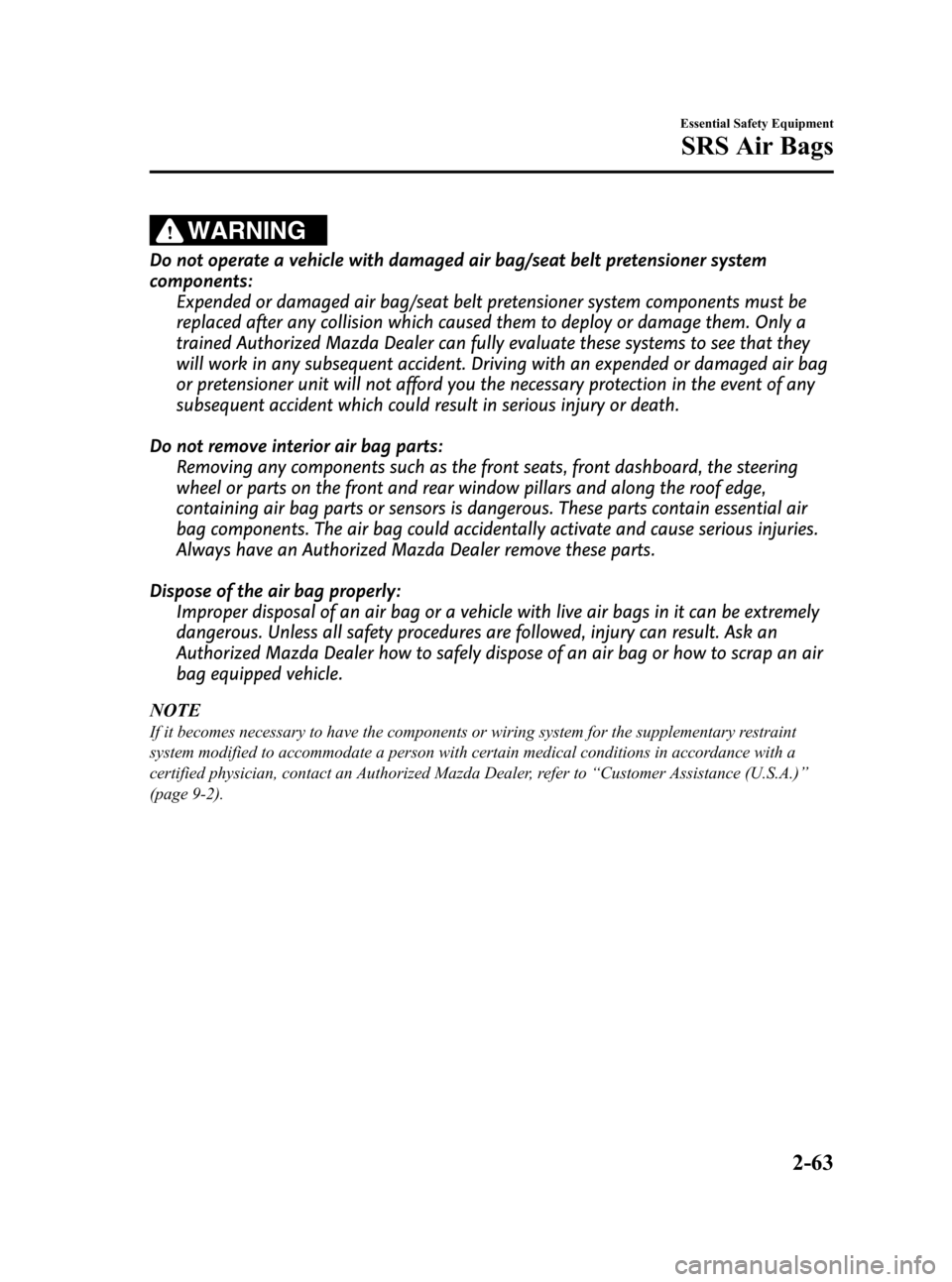
Black plate (77,1)
WARNING
Do not operate a vehicle with damaged air bag/seat belt pretensioner system
components:Expended or damaged air bag/seat belt pretensioner system components must be
replaced after any collision which caused them to deploy or damage them. Only a
trained Authorized Mazda Dealer can fully evaluate these systems to see that they
will work in any subsequent accident. Driving with an expended or damaged air bag
or pretensioner unit will not afford you the necessary protection in the event of any
subsequent accident which could result in serious injury or death.
Do not remove interior air bag parts: Removing any components such as the front seats, front dashboard, the steering
wheel or parts on the front and rear window pillars and along the roof edge,
containing air bag parts or sensors is dangerous. These parts contain essential air
bag components. The air bag could accidentally activate and cause serious injuries.
Always have an Authorized Mazda Dealer remove these parts.
Dispose of the air bag properly: Improper disposal of an air bag or a vehicle with live air bags in it can be extremely
dangerous. Unless all safety procedures are followed, injury can result. Ask an
Authorized Mazda Dealer how to safely dispose of an air bag or how to scrap an air
bag equipped vehicle.
NOTE
If it becomes necessary to have the components or wiring system for the supplementary restraint
system modified to accommodate a person with certain medical conditions in accordance with a
certified physician, contact an Authorized Mazda Dealer, refer to “Customer Assistance (U.S.A.) ”
(page 9-2).
Essential Safety Equipment
SRS Air Bags
2-63
Mazda3_8BY7-EC-11F_Edition1 Page77
Friday, June 17 2011 2:54 PM
Form No.8BY7-EC-11F